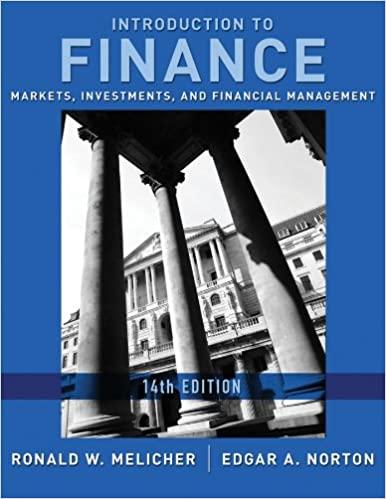Question
INVESTING YOUR OWN PORTFOLIO You have won the jackpot of a European Lottery with a prize of 30 000. After distributing a portion of the
INVESTING YOUR OWN PORTFOLIO
You have won the jackpot of a European Lottery with a prize of 30 000. After distributing a portion of the prize to a local charity, you decide that it is a good idea to invest the rest of the prize. However, you are doubtful about which asset class or financial vehicle is more suitable given the current international context.
Bear in mind that you are in your early twenties and that your financial restrictions are negligible. While you are Not a Risk Lover, you feel comfortable with a portfolio with a high risk-reward profile. You seek professional advice and contact two recognized investment advisors.
Investment Advice Summary
You had a virtual meeting with each of advisor and then you summed-up their financial advices as follows:
| Advisor 1 | Advisor 2 | |
| Percentage invested in Bonds | 85% | 40% |
| Percentage invested in Equity | 15% | 60% |
| Investment Vehicle | Mutual Funds | Exchange Traded Funds (ETF) |
| Geographic Exposure | European Funds only | Global ETFs |
| Currency Exposure | Unhedged | 80% FX-hedging into your local currency |
| Liquidity | Low to Moderate | High |
| Portfolio management style | Active | Passive |
| Rebalancing Frequency | Every six months | Every two years |
3- Capital Allocation Line (CAL):
After a few of weeks of deliberation, you made-up your mind and you selected an advisor, who is not any of the advisors that you initially interviewed. In a follow-up email, you learned that most of your portfolio is invested in a risky asset (global megatrends equity ETF) with an expected rate of return of 13% and standard deviation of 19%. The relevant risk-free rate is 2%. (4 points each question; total of 20 points)
- The strategic asset allocation of your portfolio is 70% in a global equity ETF and 30% in a risk-free money market fund. What is the expected return on your portfolio?
- Which is the standard deviation of the rate of return on your portfolio?
- What is the reward-to-volatility ratio (Sharpe ratio) of the global equity ETF? Which is the Sharpe ratio of your portfolio?
- Imagine that you want to draw a Capital Allocation Line (CAL) with these data, which is the value of its intercept? Which would be its slope?
- If the risk-free rate were to increase to 5%, what would happen to CAL that you have drawn?
Step by Step Solution
There are 3 Steps involved in it
Step: 1

Get Instant Access to Expert-Tailored Solutions
See step-by-step solutions with expert insights and AI powered tools for academic success
Step: 2

Step: 3

Ace Your Homework with AI
Get the answers you need in no time with our AI-driven, step-by-step assistance
Get Started


